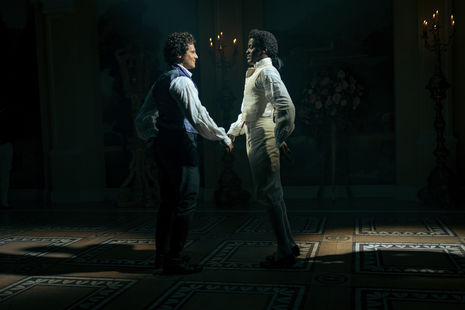Queer kisses in Doctor Who are nothing new
Disney should not get the credit for something that has long been part of the show

As my neighbours who portered me can confirm, my friends and I have sung, shouted and screamed our way through most of the new season of Doctor Who – and were perhaps loudest during ‘Rogue’. The episode saw Ncuti Gatwa’s Doctor develop a romance with the suave (read: hot) D&D nerd (read: really hot) and bounty hunter played by Jonathan Groff, culminating in a tear-jerking kiss and tragically abrupt ending. Like clockwork, an onslaught of newspaper articles (which have since been hastily edited) celebrated the “first same-sex kiss” in the show’s 60-year history – just in time for Pride Month and a herald of the new, Disney-fied era to come.
“The first same-sex kiss occurred 19 years ago in the explosive season one finale”
Except it isn’t. The first same-sex kiss occurred 19 years ago in the explosive season one finale between Christopher Eccleston’s Doctor (a butch icon, we can agree) and Captain Jack Harkness. Subsequently, there have been kisses between the Doctor and Rory, Jenny and Vastra, Bill and Heather, and Jake and Adam – without mentioning the spinoffs, Torchwood and Class (listing all the queer kisses in those shows would make this article unreadably long). To sum it up snappily, the articles were wrong.
However, when it comes to Doctor Who, brevity is not my forte. It’s not simply the inaccuracy I take issue with; my main problem is the credit given to Disney. It’s common knowledge that Disney takes rainbow capitalism to the extreme. They might make their profile picture rainbow-coloured during June or sell some rainbow T-shirts. However, they will simultaneously limit meaningful queer representation in their media and donate profits to politicians promoting anti-LGBTQ+ laws.
“It’s common knowledge that Disney takes rainbow capitalism to the extreme”
Crediting Disney with Doctor Who’s first queer kiss plays into their narrative and ignores the work of actual queer people long before Disney got near the show. When Russell T Davies took control in 2005, the pressure was on: there had been no Doctor Who since the 1996 TV movie and no episodes since 1989. So Davies, a gay Doctor Who fan whose previous success came from Queer As Folk, wrote what he knew: aliens, spaceships and men kissing.
Having the Doctor and Rogue kiss remains a meaningful decision. Following years of vitriol directed at Jodie Whittaker’s Doctor and general complaints about the show “going woke”, it’s vital that its message of acceptance and love isn’t lost. But suggesting ‘Rogue’ is the first episode to do so ignores the bravery of the first season’s kiss, when the show was still in its infancy, barely two years after Section 28 was repealed and eight years before gay marriage was legalised in England and Wales.
“Having the Doctor and Rogue kiss remains a meaningful decision”
And there’s another problem (I told you I couldn’t be brief): the specific focus on kissing. Of course, it’s a useful signifier of a relationship, especially for the media-illiterate (it makes queerness so obvious it cannot be denied). But it also highlights the sexualisation of LGBTQ+ characters in media by ignoring the fact that there’s enough queerness in Doctor Who to fill a TARDIS and those characters are equally valid without a kiss. Characters who spend an episode fighting aliens and becoming fan favourites before revealing their sexuality at the end (Canton Everett Delaware III, my beloved) serve as reminders that you can’t always tell who around you is queer – we’re like zygons hiding in human shells.
Casual references to same-sex partners from River Song and Clara Oswald allow characters to embrace their queerness without having to “prove” anything. If not for the unfortunate cancellation of The Sarah Jane Adventures, Luke Smith would’ve been one of the first queer characters on children’s TV, extending the much-needed portrayal to a younger audience. Recently, the Thirteenth Doctor and Yaz admitted their feelings for each other and provided very necessary representation to pining sapphics. The fact that they never kissed changes nothing.
Looking around my room while writing, I see a lesbian flag, a TARDIS clock, 17 Doctor Who postcards, a rainbow flag, two messages in Gallifreyan from my friend and my partner, and a Dalek. It should come as a surprise to no-one (not least anyone I’ve cornered to discuss it) that queer representation in Doctor Who is close to my heart. I adore how explicitly queer recent episodes have been; the Fourteenth Doctor calling Isaac Newton hot, Ruby and Fifteen fighting over Ricky September and the gorgeous Regency-era kiss have all resulted in my friend group grabbing each other’s arms and squealing (again, I can only apologise to my neighbours). But the queerness isn’t new. It’s as old as the show – quite literally, as ‘An Unearthly Child’ was directed by Warris Hussein, a gay man, all the way back in 1963.
So please, continue to enjoy this campy new era and let us hope we see more of Ncuti Gatwa dancing to Kylie Minogue soon. But maybe take a trip in the TARDIS back to previous eras of the show and remember that it has always been – firmly and loudly – queer.
 Interviews / You don’t need to peak at Cambridge, says Robin Harding31 December 2025
Interviews / You don’t need to peak at Cambridge, says Robin Harding31 December 2025 News / Unions protest handling of redundancies at Epidemiology Unit30 December 2025
News / Unions protest handling of redundancies at Epidemiology Unit30 December 2025 Comment / What happened to men at Cambridge?31 December 2025
Comment / What happened to men at Cambridge?31 December 2025 Features / ‘Treated like we’re incompetent’: ents officers on college micromanagement30 December 2025
Features / ‘Treated like we’re incompetent’: ents officers on college micromanagement30 December 2025 Theatre / We should be filming ADC productions31 December 2025
Theatre / We should be filming ADC productions31 December 2025









